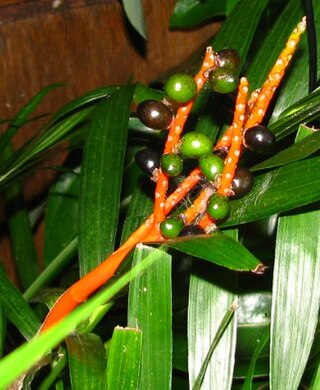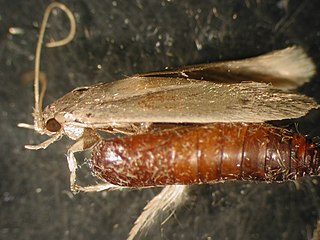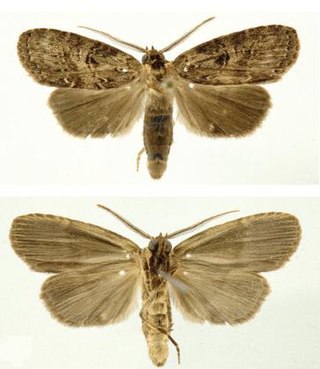The Palm and Cycad Arboretum at the Florida State College at Jacksonville is located on the south campus at 11901 Beach Boulevard, Jacksonville, Florida, United States. This is an outdoor area next to the G building, a large three-story complex in the middle of campus that houses the library and other facilities. There is also a biologically diverse area of larger trees and mid-growth brush in an immediate westerly direction to this area. As the Arboretum is an open area, there are no specific set hours, and its use is free and available to all students and visitors.

Notodontidae is a family of moths with approximately 3,800 known species. The family was described by James Francis Stephens in 1829. Moths of this family are found in all parts of the world, but they are most concentrated in tropical areas, especially in the New World.

Chamaedorea is a genus of 107 species of palms, native to subtropical and tropical regions of the Americas. They are small palms, growing to 0.3–6 m tall with slender, cane-like stems, growing in the understory in rainforests, and often spreading by means of underground runners, forming clonal colonies. The leaves are pinnate, with one to numerous leaflets. The flowers are produced in inflorescences; they are dioecious, with male and female flowers on separate plants. The fruit is an orange or red drupe 0.5–2 cm diameter. Perhaps the best-known species is Chamaedorea elegans from Mexico and Guatemala. It is popular as a houseplant, particularly in Victorian houses. Another well-known species is Chamaedorea seifrizii, the bamboo palm or reed palm.

Chamaedorea elegans, the neanthe bella palm or parlour palm, is a species of small palm tree native to the rainforests in Southern Mexico and Guatemala. The parlor palm is one of the most extensively sold houseplant palms in the world. It is one of several species with leaves that are harvested as xate.
Scotura annulata is a moth of the family Notodontidae. It is found from Texas, south through Central America to Argentina.
Pikroprion is a genus of moths of the family Notodontidae. It consists of only one species, Pikroprion sullivani, which is endemic to the Choco habitat along the western slopes of the Andes in Ecuador and Colombia.

Chamaedorea cataractarum, the cat palm, cascade palm, or cataract palm, is a small palm tree. It is native to Southern Mexico and Central America.

Opogona sacchari, the banana moth, is a moth of the family Tineidae. The species was first described by Wenceslas Bojer in 1856. It is native to the humid tropical and subtropical regions of sub-Saharan Africa, where it is also found in Madagascar, Mauritius, Réunion, Rodrigues Island, the Seychelles and St. Helena. It was first reported from the Canary Islands in the 1920s. In the 1970s, it was introduced into Brazil and Central America, and also appeared in Europe. It has been reported from Florida since 1986.
Erbessa thiaucourti is a moth of the family Notodontidae first described by James S. Miller in 2008. It is found in French Guiana.
Xenomigia involuta is a moth of the family Notodontidae. It is endemic to cloud forests on the western slope of the Ecuadorian Andes.
Tithraustes noctiluces is a moth of the family Notodontidae. It is found in Panama, Costa Rica and El Salvador.

Dunama jessiehillae is a moth in the family Notodontidae. It is found in Costa Rica, where it is only known from the east slope of the Cordillera Volcanica de Guanacaste and Tilaran, and in the Sarapiqui lowlands, at elevations ranging from 40 to 1,500 meters. Larvae have only been encountered at mid-elevations on the same slopes.

Dunama janewaldronae is a moth in the family Notodontidae. It is found in Costa Rica, where it is known from the eastern side of the Cordillera Volcanica de Guanacaste at elevations ranging from 400 to 680 meters.

Dunama jessiebancroftae is a moth in the family Notodontidae. It is found in Costa Rica, where it is known from the Peninsula de Nicoya, and the lowland of central Pacific Costa Rica, at elevations ranging from 50 to 1,286 metres.

Dunama janecoxae is a moth in the family Notodontidae. It is found in Costa Rica, where it is known from the Cordillera Volcanica de Guanacaste and the eastern slope of the Cordillera de Tilaran and Talamanca, occurring at elevations ranging from 1,090 to 1,185 meters.
Dunama mexicana is a moth in the family Notodontidae. It is found in Mexico.

Chamaedorea ernesti-augusti is species of small palm tree. It was first described scientifically in 1852 by Hermann Wendland. It is one of several species with leaves that are harvested as xate.
Natalie Whitford Uhl (1919–2017) was an American botanist who specialised in palms.

Chamaedorea costaricana is a species of palm in the genus Chamaedorea, found in Central America. A common local name in Costa Rica is pacaya, though this is also used as a name for Chamaedorea tepejilote.

Chamaedorea seifrizii, commonly known as bamboo palm, parlor palm, or reed palm, is a species of plant in the family Arecaceae. It is a subtropical palm that grows up to 20 feet tall, and is commonly used as a houseplant. The evergreen leaves are pinnately divided, and yellow flowers are borne on a panicle. The fruit are small, round, and black.










